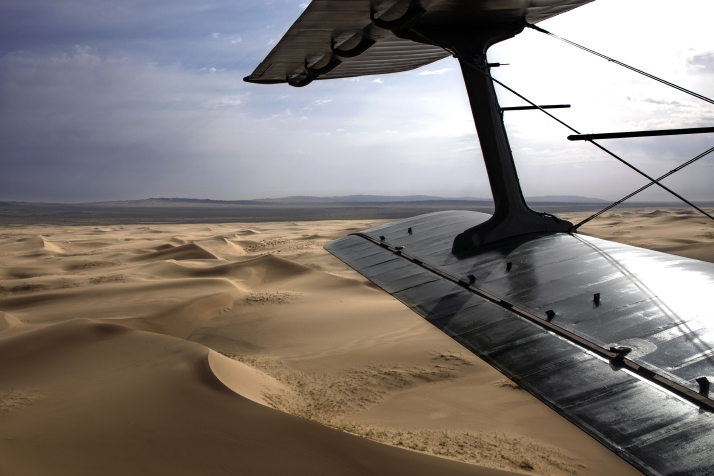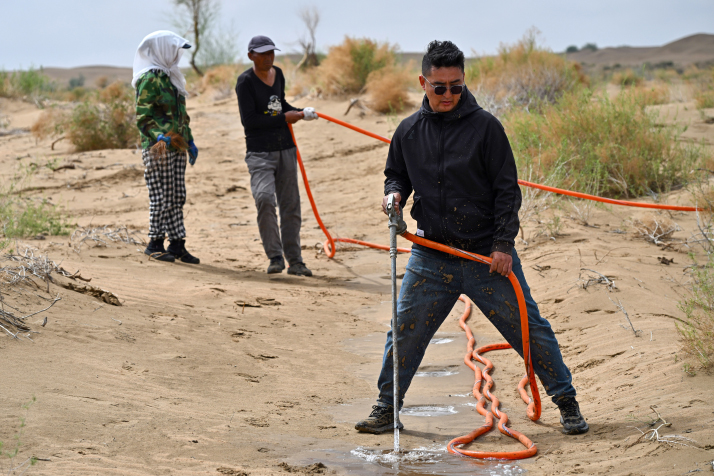| China |
| Innovation empowers the battle against desertification and sandification in China | |
|
|
 A plane carries out aerial seeding in Alxa League, Inner Mongolia Autonomous Region, on June 9, 2020 (XINHUA)
With birds chirping and lush plants swaying in the breeze, the shelterbelts in the once barren sand sea in Alxa Left Banner, a county-level administrative division, are brimming with vitality. Alxa Left Banner is part of Alxa League in the western part of Inner Mongolia Autonomous Region. The league, an administrative division corresponding to a prefecture, is home to three of China's major deserts, the Badain Jaran, Tengger and Ulan Buh, which are major sources of sandstorms across north China, including in the capital Beijing. Through aerial seeding and other desertification control and afforestation efforts, two large shelterbelts have been built on the southeastern edge of the Tengger and Ulan Buh deserts. China suffered from significant desertification and sandification in the latter half of the 20th century. But this ecological deterioration is being reversed. Since 2012, a total of 20.33 million hectares of desertified land have been rehabilitated, amounting to 53 percent of all land affected by reversible desertification in the country, according to data released by the National Forestry and Grassland Administration on June 15, two days before the 30th World Day to Combat Desertification and Drought. Over the past three decades, China's fight against sand has transformed from labor-intensive to technology-rich, with advanced technology such as drones and robots now used to green the deserts. 'Smart' seeds Aerial seeding can be carried out more rapidly than traditional tree-planting methods, especially in areas difficult for people to access. However, the direct exposure of unburied seeds to adverse climate conditions as well as seed-eating animals can significantly reduce the germination rate. Additionally, it's widely believed that aerial seeding is not suitable for areas with annual precipitation of less than 200 mm, according to Liu Hongyi, head of the Forestry Station at Alxa Left Banner. The annual precipitation is usually no more than 150 mm in the area. Aerial seeding has been in use in Alxa League over a period of about four decades. Initially, the seeds dropped from planes tended to drift in the wind. Many failed to land in their designated areas and the seed germination and seeding survival rates were low. In recent years, an innovative coating has been created to overcome these problems. The forestry station in Alxa Left Banner, in partnership with the Cold and Arid Regions Environmental and Engineering Research Institute of the Chinese Academy of Sciences and a local technology company, has developed pelleted seeds coated with a biodegradable covering to increase the seed size for easier planting. Mass production of the pelleted seeds began in a local factory in 2000. "The weight of the pelleted seeds we produce is at least twice that of the original seeds. During the aerial seeding process, these seeds can be accurately dropped into designated areas and they dive deep in sand dunes," said Wu Zhibo, a senior engineer at the Forestry and Desertification Research Institute of Alxa League. He added that these artificially coated seeds are "very smart," as only when rainfall reaches the required level for germination, will the coating crack and the seeds germinate, and this reduces seed waste. Environmentally friendly repellents have been added to the coating to protect seeds from being eaten by rodents and birds. Liu said the right place for aerial seeding is at the edge of the desert with less than 5 percent vegetation coverage, and the suitable time is in June or July, when the rainfall is relatively high. No more than 500 grams of seed should be sown per acre of land as water resources are too scarce to support higher volumes, and a grazing ban should be imposed after the seeding to prevent livestock from destroying seedlings, he continued. The pelleted seed technology increases the seedling survival rate by about 15 percent, reduces the amount of seed needed by 50 percent, and has been adopted for use in other desertification-affected areas, according to the Science and Technology Department of Inner Mongolia. The shelterbelts established in Alxa Left Banner are part of the Three-North Shelterbelt Forest Program, established to protect northwest, north and northeast China from encroaching sand. Launched in 1978, it is the largest afforestation project in the world and is scheduled to be completed in 2050. According to Xinhua News Agency, the forest coverage rate in the areas included in the program increased from 5.05 percent in 1978 to 13.84 percent in 2023. By 2050, the program will cover more than 4 million square km across 13 provincial-level regions, accounting for 42.4 percent of the country's total land area.  Workers plant trees with a minimally invasive method in the Kubuqi Desert in Hanggin Banner, Inner Mongolia Autonomous Region, on June 5 (XINHUA)
From spade to robot In the Kubuqi Desert in west Inner Mongolia, the seventh largest desert in China covering an area of 18,000 square km, shelterbelts are also being built with innovative and efficient tree-planting methods. Gao Maohu, an employee of Elion Resource Group in Hanggin Banner in Ordos City, has been planting trees in the Kubuqi Desert for more than three decades. Elion, founded in 1988, is a leading Chinese green industry enterprise. It has invested heavily in restoring the ecology of the Kubuqi Desert, invented various sand-treatment methods and encouraged local farmers and herders to participate in the efforts. At first, it took Gao more than 10 minutes to plant each tree, using a shovel to dig a large hole in ground covered by straw checkerboard barriers, which stabilize the soil and prevent moisture loss. Later, he began using a hydro-powered or electric spiral drill, which drills holes for planting seedlings without using any straw checkerboard. "With the minimally invasive technique, planting a tree required only 10 seconds, and the survival rate is more than 90 percent," Gao told Chinanews.com. Now, robots are used to make tree-planting even more efficient and effective. With the development of artificial intelligence technology, Elion has developed an intelligent sand control robot. He Pengfei, one of the group's executives, said the robot can independently design the optimal tree-planting routes and carry out afforestation operations. "The robot's afforestation efficiency is more than five times that of manual labor," he told Chinanews.com. The afforestation efforts in the Kubuqi Desert have yielded impressive results. Its vegetation coverage rate has now reached 53 percent, the number of sandstorm days there has decreased by 95 percent from 40 years ago, the number of wildlife species has increased by 10 times, and the annual rainfall has increased from less than 70 mm to over 300 mm, according to the Forestry and Grassland Administration of Ordos. As the efficiency of tech-empowered afforestation increases, a question arises: Should all deserts be afforested? In deserts, natural precipitation alone cannot support the growth of a large number of trees, Wu Bo, Director of the Institute of Desertification Studies of the Chinese Academy of Forestry, said. He pointed out that afforestation of large areas or at high densities can lower groundwater levels, deplete soil moisture, and lead to the collapse of desert ecosystems. "Scientific research has long shown that only land desertified by climate change or human activity can be and needs to be treated, and the treatment method is not limited to planting trees. It should be treated with a combination of trees, shrubs and grass," he said, adding that the restored vegetation should not exceed the carrying capacity of local water resources. Copyedited by G.P. Wilson Comments to wanghairong@cicgamericas.com |
|
||||||||||||||||||||||||||||||
|